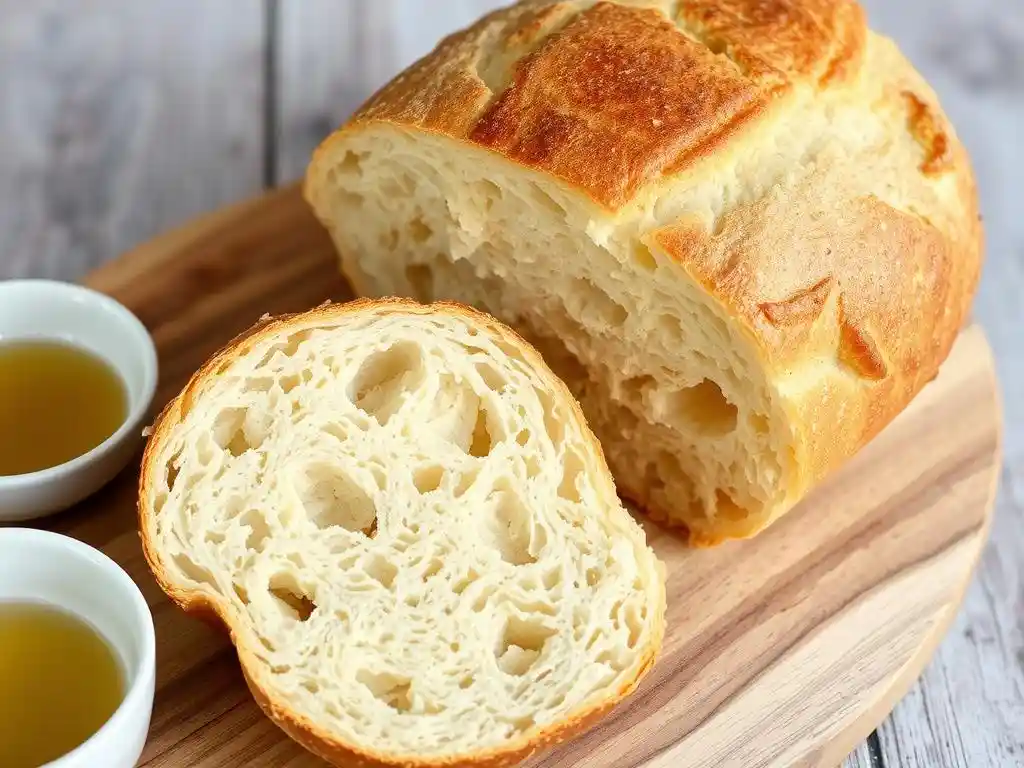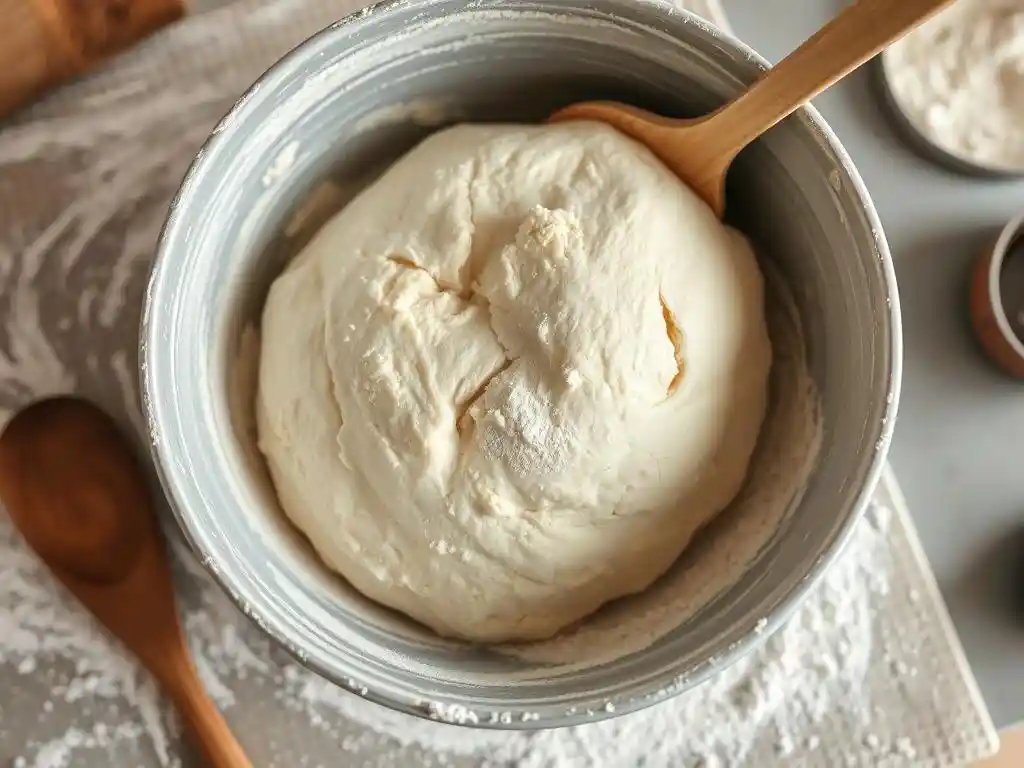Mastering the Art of Airy Crust & Chewy Delight
Table of Contents
- What is Ciabatta Bread?
- How to Pronounce Ciabatta
- Is Ciabatta Bread Healthy?
- How to Make Ciabatta Bread
- Ingredients for Ciabatta
- Step-by-Step Ciabatta Recipe
- Helpful Baking Tips
- Related Recipes
- FAQs
What is Ciabatta Bread?
Ciabatta bread is a rustic Italian bread known for its crusty exterior and airy, chewy interior. It was created in the 1980s by Italian baker Arnaldo Cavallari, who sought to craft a bread that would perfectly pair with Italy’s rich olive oil. “Ciabatta,” meaning “slipper” in Italian, reflects the bread’s flat, elongated shape.
With its delicate flavor, ciabatta is perfect for paninis, sandwiches, and dipping in oils and spreads. Although it may look complex, ciabatta bread is simple to make and highly rewarding once you learn a few essential techniques.
How to Pronounce Ciabatta
Pronouncing ciabatta correctly is straightforward. In Italian, it’s pronounced as “cha-BAH-ttah” (with a soft “ch” sound). This simple pronunciation is a helpful reminder of its Italian roots, bringing an authentic touch to any kitchen as you bake.
Is Ciabatta Bread Healthy?
When it comes to health, ciabatta bread offers both benefits and considerations. Like other artisanal breads, ciabatta is made with minimal ingredients: flour, water, salt, and yeast. This simplicity makes it a healthier option than heavily processed breads. However, ciabatta can also be high in calories and carbohydrates, so it’s best enjoyed in moderation, especially for those on a low-carb diet.
Some variations use whole wheat flour for added fiber, but traditional ciabatta bread is made with refined white flour, giving it that signature light texture and airy crumb. To explore other low-carb bread options, consider checking out our recipe for Authentic Mexican Low-Carb Tortillas.

How to Make Ciabatta Bread
Making ciabatta bread involves a few steps, but mastering this artful bread is achievable and rewarding. Here’s a quick overview before we dive into the step-by-step recipe:
- Mix the Dough: Use a high-hydration dough to achieve the soft, airy crumb ciabatta is known for.
- Bulk Fermentation: Let the dough rest and rise, developing its flavor.
- Shaping the Loaf: Shape the dough loosely for the characteristic slipper shape.
- Baking: Bake at high heat to create the perfect crust while keeping the inside tender.
This method results in ciabatta bread that’s wonderfully chewy with that signature crispy crust. Be prepared to use wet dough techniques and minimal handling to preserve the air bubbles in the dough.
Ingredients for Ciabatta
For a traditional ciabatta bread recipe, you’ll need the following ingredients:
- 500g Bread Flour: Look for high-protein flour to develop gluten, or learn more about Flour Types and Equivalents in the US.
- 400g Water: A high hydration level is crucial for that airy texture.
- 10g Salt: Enhances flavor and strengthens gluten.
- 2g Yeast: This small amount ensures a slow fermentation for rich flavor.
Step-by-Step Ciabatta Recipe
Step 1: Mix the Dough
In a large mixing bowl, combine the bread flour and salt. Dissolve the yeast in water, then add it to the dry ingredients. Mix gently until combined. The dough will be wet and sticky, but that’s essential for ciabatta’s open crumb.
Step 2: First Rise (Bulk Fermentation)
Cover the dough and let it rise at room temperature for 1-2 hours, or until it has doubled in size. Use the folding technique: every 30 minutes, gently stretch and fold the dough over itself to develop gluten and incorporate air.
Step 3: Shaping
Once the dough has doubled, transfer it to a floured surface. Lightly shape it into a rectangle without deflating it. Cut the dough in half, and shape each half loosely into a slipper shape. Avoid heavy handling to maintain the air pockets.
Step 4: Proofing
Cover the loaves with a floured cloth and let them proof for 45 minutes. During this time, preheat your oven to 475°F (245°C), setting a baking stone or an overturned baking sheet inside to heat up.
Step 5: Baking
Place the ciabatta loaves onto the hot surface, then quickly add steam by misting the oven or placing a pan of water inside. Bake for 20-25 minutes or until the crust is golden and the loaves sound hollow when tapped.

Helpful Baking Tips
- Hydration is Key: Ciabatta dough is high-hydration, resulting in a sticky dough that may feel difficult to handle. Using minimal flour on your hands and working with a bench scraper can make handling easier.
- Use a Baking Stone: Baking on a preheated stone helps achieve a crisp bottom crust. Check out our Mastering Crispy Crust Focaccia guide for tips on getting that perfect crust.
- Add Steam to Your Oven: Steam prevents the crust from hardening too quickly, allowing the bread to expand fully before setting. You can create steam by misting the dough with water right before closing the oven door or adding a small pan of water.
- Practice Patience: Good ciabatta requires time. Letting the dough ferment slowly enhances flavor and helps develop the texture unique to ciabatta bread.
- Experiment with Whole-Wheat Flour: To add nutritional value, substitute part of the bread flour with whole-wheat flour. For more on the nutritional effects, see this article on ciabatta bread’s health benefits and considerations.
Related Recipes
Looking to diversify your bread-baking skills? Try these related recipes for a deeper dive into artisanal breads:
- Authentic Mexican Low-Carb Tortillas: A healthy, versatile option to enjoy alongside ciabatta.
- Mastering Crispy Crust Focaccia: Perfect your crust technique with this foolproof focaccia recipe.
FAQs
What does ciabatta mean?
Ciabatta means “slipper” in Italian, a fitting name given the bread’s flat, slipper-like shape.
Can I make ciabatta without a stand mixer?
Absolutely. The folding technique is a great alternative to kneading by hand or machine, preserving the airy structure.
How long will ciabatta stay fresh?
Ciabatta is best enjoyed fresh but can be stored in an airtight container at room temperature for up to 2 days. It also freezes well.
What’s the difference between ciabatta and focaccia?
Ciabatta is a light, airy bread often baked freeform, while focaccia is thicker and typically flavored with olive oil and herbs.
Summary
Ciabatta bread is a classic Italian loaf known for its airy, chewy texture and unique flavor. With this easy recipe, you’ll master the essential techniques for making authentic ciabatta bread at home. Whether you’re a novice baker or a seasoned pro, our step-by-step guide simplifies the process, helping you achieve bakery-quality results with ease. Enjoy your homemade ciabatta bread in sandwiches, paninis, or simply dipped in olive oil. Bake your way to Italian perfection!


1 thought on “Ciabatta Bread Recipe”